An online project under the direction of the CAPE ANN MUSEUM
inv. 249
"Starlight" in Harbor
"Star Light," 1153 Tons, Built at South Boston, Mass., in 1854; Ship "Star Light" in Boston Harbor; Ship "Starlight" in the Fog
c. 1855 Oil on canvas 24 1/4 x 36 1/8 in. (61.6 x 91.8 cm) No inscription found
|
Supplementary Images
Explore catalog entries by keywords view all keywords »
Historical Materials
Below is historical information related to the Lane work above. To see complete information on a subject on the Historical Materials page, click on the subject name (in bold and underlined).
Baker & Morrill had "Star Light" built for them.
Reference:
See Erik Ronnberg in Alan Granby, A Yachtsman's Eye: The Glen S. Foster Collection of Marine Paintings (Philadelphia: Independence Seaport Museum; in association with W.W. Norton, 2005).
During the years after the war of 1812 and before the Civil War, the port of Boston was a center of American deep-water shipping. Trading with China, India, and the West Indies, which had fueled maritime growth in the early years of the century gave way to re-exporting these goods and foreign trade based on the shoe and textile trades. Although second to New York in terms of shipping tonnage, many of New York's shipbuilders and merchants were Boston based. In addition, ship building continued in Boston. Also, the coastal trade (the domestic trade up and down the coast) was still the most efficient way to transport goods and passengers, and accounts for much of the tonnage and shipping traffic.
Although dwarfed by New York, Boston was an active port in the 1840s and 1850s. Its registered tonnage rose from 149,186 in 1840 to 270,510 in 1850. The harbor was a crowded place. For example, on September 18, 1850, 32 ships, 49 barks, 47 brigs, and 52 schooners were reported at Boston.(1)
In 1849, foreign entries at Boston included 215 ships, 305 barks, 908 brigs, and 52 schooners. Coastwise arrivals included 193 ships, 488 barks, 1087 brigs, 4287 schooners, 89 sloops, and 65 schooners.(2)
(1) W.H. Bunting, p.8.
(2) Ibid.
For more information:
Samuel Eliot Morrison, The Maritime History of Massachusetts, 1783-1860
W.H. Bunting, Portrait of a Port, Boston 1852-1914 Cambridge: The Belknap Press of Harvard University, 1971.
Printed map inside Boston Almanac
Published by B. B. Mussey & Co. and Thomas Groom, Boston
Cape Ann Museum Library & Archive (R910.45 B65 1848)
Map at front of almanac with Tremont Temple highlighted.
Also filed under: Boston City Views » // Maps » // Tremont Temple »
Harvard Depository: Widener (NAV 578.57)
For digitized version, click here.
Also filed under: Signal Systems (Flags & Maritime Codes) »
Tinted lithograph with hand coloring
13 7/8 x 22 3/8 in.
Boston Athenaeum
From Sally Pierce and Catharina Slautterback, Boston Lithography, 1825–1880: The Boston Atheneaum Collection (Boston: Athenaeum, 1991): "Tidd drew this print when he was a consulting engineer for Simpson's. He has depicted the clipper ship 'Southern Cross' in the dry dock. Built in 1851, she was known for having sailed from San Francisco to Hong Kong in the record breaking time of thirty-two days. The Bethlehem Ship Building Company eventually took over this location and operated a dry dock there until the mid 1940s."
Also filed under: "Southern Cross" (Clipper Ship) » // M. M. Tidd, Lith. – Boston »
Library of Congress Catalog Number 2004671768
Also filed under: "Britannia" (Cunard Steamship) »
1853
Bostonian Society (1884.0209)
Also filed under: Scott, John W. A. »
1 print : lithograph, tinted ; image 50.3 x 111.9 cm., 68.7 x 121.2 cm.
View of the city of Boston from East Boston showing Boston Harbor. The wharves of East Boston can be seen in the foreground.
Number nine of thirty-eight city views published in "Whitefield's Original Views of (North) American Cities (Scenery).
On stone by Charles W. Burton after a drawing by Edwin Whitefield.
Inscribed in brown ink lower right corner of sheet: "Boston Athenaeum from Josiah Quincy. September 28, 1848."
Local Notes:#1848.1.
"'Star Light' was built for the Boston firm of Baker & Morrill and was launched from the South Boston shipyard of E. & H. O. Briggs on February 11, 1854. Regarded as a medium (as opposed to extreme) clipper, she made several fast passages to San Francisco, returning via the Far East. Lane probably saw and sketched her after her launch and fitting-out, returning to his Gloucester studio to do the painting." (1)
Information in the above table description applies to "Starlight" in Harbor, c.1855 (inv. 249) only. The vessel in Ship "Starlight", c.1860 (inv. 65) differs significantly in hull form and detail, but no other ship named "Star Light" matches the painting. It should be borne in mind that there are numerous major gaps in the registry records for vessels built in New England and the "Star Light" in Ship "Starlight", c.1860 (inv. 65) may well be one of those vessels whose official records are lost.
– Erik Ronnberg
References:
1. Erik Ronnberg in Alan Granby et al. A Yachtsman's Eye: The Glen S. Foster Collection of Marine Paintings (Philadelphia, PA: Independence Seaport Museum; in association with W.W. Norton, 2005), 200.
See also Octavius T. Howe, and Frederick C. Matthews. American Clipper Ships: 1833–1858. Salem, MA: Marine Research Society, 1927.
The term "ship," as used by nineteenth-century merchants and seamen, referred to a large three-masted sailing vessel which was square-rigged on all three masts. (1) In that same period, sailing warships of the largest classes were also called ships, or more formally, ships of the line, their size qualifying them to engage the enemy in a line of battle. (2) In the second half of the nineteenth century, as sailing vessels were replaced by engine-powered vessels, the term ship was applied to any large vessel, regardless of propulsion or use. (3)
Ships were often further defined by their specialized uses or modifications, clipper ships and packet ships being the most noted examples. Built for speed, clipper ships were employed in carrying high-value or perishable goods over long distances. (4) Lane painted formal portraits of clipper ships for their owners, as well as generic examples for his port paintings. (5)
Packet ships were designed for carrying capacity which required some sacrifice in speed while still being able to make scheduled passages within a reasonable time frame between regular destinations. In the packet trade with European ports, mail, passengers, and bulk cargos such as cotton, textiles, and farm produce made the eastward passages. Mail, passengers (usually in much larger numbers), and finished wares were the usual cargos for return trips. (6) Lane depicted these vessels in portraits for their owners, and in his port scenes of Boston and New York Harbors.
Ships in specific trades were often identified by their cargos: salt ships which brought salt to Gloucester for curing dried fish; tea clippers in the China Trade; coffee ships in the West Indies and South American trades, and cotton ships bringing cotton to mills in New England or to European ports. Some trades were identified by the special destination of a ship’s regular voyages; hence Gloucester vessels in the trade with Surinam were identified as Surinam ships (or barks, or brigs, depending on their rigs). In Lane’s Gloucester Harbor scenes, there are likely (though not identifiable) examples of Surinam ships, but only the ship "California" in his depiction of the Burnham marine railway in Gloucester (see Three Master on the Gloucester Railways, 1857 (inv. 29)) is so identified. (7)
– Erik Ronnberg
References:
1. R[ichard)] H[enry] Dana, Jr., The Seaman’s Friend, 13th ed. (Boston: Thomas Groom & Co., 1873), p. 121 and Plate IV with captions.
2. A Naval Encyclopaedia (Philadelphia: L. R. Hamersly & Co., 1884), 739, 741.
3. M.H. Parry, et al., Aak to Zumbra: A Dictionary of the World’s Watercraft (Newport News, VA: The Mariners’ Museum, 2000), 536.
4. Howard I. Chapelle, The History of American Sailing Ships (New York: W.W. Norton & Co., 1935), 281–87.
5. Ibid.
6. Howard I. Chapelle, The National Watercraft Collection (Washington, DC: Smithsonian Institution, 1960), 26–30.
7. Alfred Mansfield Brooks, Gloucester Recollected: A Familiar History (Gloucester, MA: Peter Smith, 1974), 67–69.
Photograph
From American Clipper Ships 1833–1858, by Octavius T. Howe and Frederick C. Matthews, vol. 1 (Salem, MA: Marine Research Society, 1926).
Photo caption reads: "'Golden State' 1363 tons, built at New York, in 1852. From a photograph showing her in dock at Quebec in 1884."
Also filed under: "Golden State" (Clipper Ship) »
Oil on canvas
24 x 35 in.
Peabody Essex Museum, Salem, Mass.
Walters' painting depicts the "Nonantum" homeward bound for Boston from Liverpool in 1842. The paddle-steamer is one of the four Clyde-built Britannia-class vessels, of which one is visible crossing in the opposite direction.
View related Fitz Henry Lane catalog entries (2) »
Also filed under: Packet Shipping » // Walters, Samuel »
Sloops are one-masted sailing vessels which, in American examples, set fore-and-aft sails but usually no square sails. Thus, staysails, or jibs, are set from the fore stay(s) and a quadrilateral mainsail is set from the mast and spread by a gaff and a boom. The larger sloops would often set a triangular topsail over the main sail. (1)
The sloops depicted by Lane were used in various coastal trades, each with its own requirements, which dictated the sizes and details of their hulls and rigs. Most elegant were the packet sloops, which transported passengers, mail, and higher value goods between specific ports on regular schedules. They usually measured between sixty and seventy-five feet on deck, as dictated by anticipated shipping volume. Finely finished, they usually had stern galleries—a row of windows across the transom with ornamental moldings—and varied color schemes. Examples of packet sloops are in Gloucester Harbor from Rocky Neck, 1844 (inv. 14) (center, middle ground) and Study of Ships, 1851 (inv. 141) (foreground), both of which probably made trips between Gloucester and Boston, or Gloucester and Newburyport. (2)
Another specialized sloop of similar size was the stone sloop, used to ship granite blocks from stone-loading piers around Cape Ann to other ports. They were similar in rig to packet sloops, but of heavier construction with greater hold capacity and absence of decoration. Their stout appearance was augmented by simple color schemes, or even tarred topsides, reflecting the wear and strain imposed by their heavy cargos. Lane depicted these vessels in his painting of Fresh Water Cove from Dolliver's Neck, Gloucester, Early 1850s (inv. 45), with a sloop (at left) preparing to load at wharf-side, and another (at right) sailing out with a cargo. (3)
Sloops of the more work-a-day sort are the most commonly seen examples in Lane’s paintings, most of them appearing in his views of Boston Harbor. Usually deep-loaded and looking weather-worn, they contrast sharply with the packet- and clipper ships which dominate the scene. Sloops of this type are rarely seen in Lane’s paintings of Gloucester Harbor and the Maine coast, although they were certainly needed for short-distance transportation (see Bear Island, Northeast Harbor, 1855 (inv. 24), View of Camden Mountains from Penobscot Bay, c.1852 (inv. 207), Sunrise on the Maine Coast, Mount Desert Island, 1856 (inv. 295)). For coastal Maine, lack of railroads for heavier freight and greater distances between ports made the use of schooners with larger carrying capacity a greater necessity. (4)
In Lane’s views of New York Harbor, a regional sloop variant, the Hudson River Sloop, appears in New York Harbor, c.1855 (inv. 46) (bow view, left) and A Calm Sea, c.1860 (inv. 6) (stern view, right). This type had become prominent in the Hudson River packet trade between New York City, Albany, and beyond to points north and west as far as the eastern terminus of the Erie Canal. Large vessels for their rigs, they were well-finished and well-kept, reflecting pride of ownership and rivalry among their owners and crews. (5)
– Erik Ronnberg
References:
1. A Naval Encyclopaedia (Philadelphia: L.R. Hamersly & Co., 1884. Reprint: Detroit, MI: Gale Research Company, 1971), 59. See first definition of "sloop" and definition of "sloop-rigged."
2. Robert Greenhalgh Albion, William A. Baker, and Benjamin Woods Labaree, New England and the Sea (Mystic, CT: Mystic Seaport Museum, 1972; reprinted in 1994), 127–28.
3. Howard I. Chapelle, The History of American Sailing Ships (New York: W.W. Norton & Co., 1935), 300–02.
4. Ibid., 300.
5. Ibid., 298–300.
A Naval Encyclopaedia:
Dictionary of nautical words and phrases
Special Articles on Naval Art and Science
Philadelphia: L.R. Hamersly & Co.
'Mudian, "Mugian, or Bermudian. A boat special to the Bermuda islands, usually decked, with the exception of a hatch; from 2 to 20 tons burden; it is short, of good beam, and great draft of water abaft, the stem and keel forming a curved line. It carries an immense quantity of ballast. Besides a long main- and short jib-boom, it has a long, taperking, raking mast, stepped just over the forefoot, generally unsupported by shrouds or stays; on it a jib-headed mainsail is hoisted to a height of twice, and sometimes three times, the length of the keel. This sail is triangular, stretched at its foot by a long boom. The only other sail is a small foresail or jib. They claim to be the fastest craft in the world for working to windward in smooth water, it being recorded of one that she made five miles dead to windward in the hour during a race; and though they may be laid over until they fill with water, they will not capsize.
St. George's Historical Society
Detail of painting of St. George's Harbour, Bermuda, during US Civil War, with a Confederate blockade runner anchored in the foreground.
Also filed under: Puerto Rico »
Wood, metal, cordage, cloth, paint.
Scale: ¼ in. = 1ft. (1:48)
Cape Ann Museum. Gift of Roland and Martta Blanchet (1997.17.3)
Although built in 1890 and larger than the stone sloops of Lane’s time, the "Albert Baldwin’s" hull form, rig, and loading boom are very similar to those of the 1840s and 1850s.
Also filed under: Granite Quarrying / Shipping » // Ship Models »
Tug boat is a general term for vessels of a variety of sizes designed to tow and push large vessels into and out of harbor berths, through confined waterways, and undertake towing and salvage work in deep water. Tugs designed for towing large vessels over long ocean routes are called tow boats, and are larger and more powerful than their harbor-based counterparts.
Throughout the nineteenth century, tug boats were powered with a variety of steam reciprocating engines, the "cross-head" and "walking beam" types being suitable for the early vessels driven by paddle wheels and used in protected harbors. The introduction of the screw propeller and more compact compound engines, made tug boats less susceptible to damage when used in open ocean, leading to the development of tow boats. (1)
New York Harbor was the first American seaport to make extensive use of harbor tugs, due to the size of New York Bay and anchorages therein. A multitude of wharves along the shorelines of Manhattan, Brooklyn, and the New Jersey side (not to mention river traffic from points north on the Hudson River and barge traffic from the Delaware and Hudson Canal) all contributed to a demand for their services. (2)
Boston Harbor, by contrast, was much smaller, with its wharves confined to a compact waterfront. Here, it was easier to move a vessel by warping it from pierhead to pierhead than to use a tug boat for such short-distance work. Even with expansion of the waterfront in the late nineteenth century, Boston had a far smaller harbor tug fleet than New York. (3)
What Boston did need were a few large tow boats for coastwise work. Most large shipyards north of Cape Cod needed tow boat services for sending the ships they built to southern ports for fitting-out. New York had a particular need for this service so vessels built in other yards (including Boston's) could be towed to it for completion (including sails, boats, cabin finish work, marine hardware, and sometimes even masts and rigging). Boston's proximity to New England shipyards made it the logical place to operate a towing service, and Robert Bennet Forbes was one of the first to act on this opportunity. An iron-hull, screw-propelled tow boat was built to his specifications in 1846 for Boston underwriters, who named it in his honor. (4)
– Erik Ronnberg
References:
1. Steven Lang and Peter H. Spectre, On the Hawser: A Tugboat Album (Camden, ME: Down East Books, 1980), xi–xii, 2–5.
2. Harry Johnson and Frederick S. Lightfoot, Maritime New York in Nineteenth-Century Photographs (New York: Dover Publications, Inc., 1980), ix–xii, 3, 7–8.
3. W.H. Bunting, Portrait of a Port: Boston, 1852–1914 (Boston: Belknap Press, 1977), 150.
4. Forbes, Robert Bennet, Personal Reminiscences (Boston: Little, Brown, & Co., 1892), listing of iron steam tug R.B. Forbes in appended "List of Vessels."
15 1/2 x 13 1/2 in
New York Public Library
Barcode number 33333159142682
Also filed under: New York Harbor »
Lithograph
Published by N. Currier, New York
Also filed under: Currier (& Ives) – New York » // New York Harbor » // Trinity Church »
The ensign of the United States refers to the flag of the United States when used as a maritime flag to indentify nationality. As required on entering port, a vessel would fly her own ensign at the stern, but a conventional token of respect to the host country would be to fly the flag of the host country (the United States in Boston Harbor, for example) at the foremast. See The "Britannia" Entering Boston Harbor, 1848 (inv. 49) for an example of a ship doing this. The American ensign often had the stars in the canton arranged in a circle with one large star in the center; an alternative on merchant ensigns was star-shaped constellation. In times of distress a ship would fly the ensign upside down, as can be seen in Wreck of the Roma, 1846 (inv. 250).
The use of flags on vessels is different from the use of flags on land. The importance and history of the flagpole in Fresh Water Cove in Gloucester is still being studied.
The modern meaning of the flag was forged in December 1860, when Major Robert Anderson moved the U.S. garrison from Fort Moultrie to Fort Sumter in Charleston Harbor. Adam Goodheart argues this was the opening move of the American Civil War, and the flag was used throughout northern states to symbolize American nationalism and rejection of secessionism.
Before that day, the flag had served mostly as a military ensign or a convenient marking of American territory, flown from forts, embassies, and ships, and displayed on special occasions like American Independence day. But in the weeks after Major Anderson's surprising stand, it became something different. Suddenly the Stars and Stripes flew—as it does today, and especially as it did after the September 11 attacks in 2001—from houses, from storefronts, from churches; above the village greens and college quads. For the first time American flags were mass-produced rather than individually stitched and even so, manufacturers could not keep up with demand. As the long winter of 1861 turned into spring, that old flag meant something new. The abstraction of the Union cause was transfigured into a physical thing: strips of cloth that millions of people would fight for, and many thousands die for.
– Adam Goodheart, Prologue of 1861: The Civil War Awakening (2011).
Stereograph card
Cape Ann Museum Library & Archive
A view of a Cove on the western side of Gloucester Harbor, with the landing at Brookbank. Houses are seen in the woods back. A boat with two men is in the foreground.
Also filed under: Brookbank » // Fresh Water Cove » // Historic Photographs »
Courtesy American Antiquarian Society, Worcester, Mass. (CL.F9116.011.1854 CL.F9116.011.1854)
Also filed under: Oak Hall »
Courtesy American Antiquarian Society, Worcester, Mass. (CL.F9116.011.1854)
Also filed under: Oak Hall »
Vessel ornamentation assumed two forms: carvings and color schemes. Carvings, or "ship carvings," as they are called by maritime scholars, are usually crafted in wood and painted or gilt. Many vessels were too small or their owners too frugal to permit carved embellishments, in which cases the enhancement of the vessel's color scheme was a practical alternative. This can be seen in many of the coastal vessels along the new England coast. Pinkies and Chebacco boats had handsome color schemes using only black and green with white sheer lines and limited use of red and yellow. Other combinations of inexpensive pigments were used to improve the simple looks of sloops and schooners in the packet trade, while small pleasure craft and pilot schooners enhanced their appearance in similar ways. Clipper ship owners, finding their vessels' appearance impressive without adding color, settled for unrelieved black hulls. Naval vessels as well preserved their formidable looks with black, relieved only with a white belt in way of the gunports.
The more elaborate ship carvings can be classified in the following categories:
Billetheads: mounted on the bow, at the end of a simple gammon knee, or on the forward end of an elaborate stem-head, they can be scrolls of less or greater intricacy, or sometimes the heads of animals, eagles being the most common. Examples of a sea serpent's head, a pointing hand, and other animal heads have been found. (See Brig "Cadet" in Gloucester Harbor, late 1840s (inv. 13); Brig "Antelope" in Boston Harbor, 1863 (inv. 43); and Brig Off the Maine Coast, 1851 (inv. 241))
Figureheads: mounted on bows of larger vessels, often with elaborate stem joinerwork (trailboards and headboards with associated knees and rails). Usually these were full-length figures representing the ship's owner, a famous citizen, a mythological person or animal, or an eagle. (See Portrait of the "National Eagle", 1853 (inv. 35) (eagle); New York Harbor, c.1855 (inv. 46); The "Britannia" Entering Boston Harbor, 1848 (inv. 49) (female figures); The Ships "Winged Arrow" and "Southern Cross" in Boston Harbor, 1853 (inv. 54) (dragon and eagle); "Starlight" in Harbor, c.1855 (inv. 249) (dragon); and Steam demi bark Antelope, 615 tons, c.1855 (inv. 375) (antelope))
Trailboards: carved vines or scrollwork abaft the figurehead which trail aft along the stem head in a graceful descending arc, terminating at the hawse pipes. They are usually gilt and frequently ornamented with carved rosettes and other devices. (See Brig "Cadet" in Gloucester Harbor, late 1840s (inv. 13); Portrait of the "National Eagle", 1853 (inv. 35); Brig "Antelope" in Boston Harbor, 1863 (inv. 43); New York Harbor, c.1855 (inv. 46); and The Ships "Winged Arrow" and "Southern Cross" in Boston Harbor, 1853 (inv. 54))
Headboards: boards mounted to headrails connecting the figurehead to the ship's mainrail at the catheads. While seldom given any decorative carvings, the vessel's nameboards were often mounted to them. (See Brig "Cadet" in Gloucester Harbor, late 1840s (inv. 13); Portrait of the "National Eagle", 1853 (inv. 35); Brig "Antelope" in Boston Harbor, 1863 (inv. 43); The Ships "Winged Arrow" and "Southern Cross" in Boston Harbor, 1853 (inv. 54); Clipper Ship "Southern Cross" in Boston Harbor, 1851 (inv. 253); and Mary Ann, 1846 (inv. 309))
Catheads: Carved lion heads mounted on the outboard ends of the cathead knees. This term is so archaic that the knees and carvings are treated as one and the same, as in their use, i.e. "catting the anchor" (securing the anchor ring to the cathead). (See Brig "Antelope" in Boston Harbor, 1863 (inv. 43); and An American Frigate Hove-to Off the New England Coast (inv. 535))
Quarterboards: Name boards mounted to the vessel's side near the stern, they usually had ornamental edge moldings and sometimes stars or simple scrollwork at each end of the name. (See Portrait of the "National Eagle", 1853 (inv. 35); Mary Ann, 1846 (inv. 309); and Spitfire Entering Boston Harbor (inv. 536))
Transom arches: arch-form panels fitted to the transom, often over gallery lights (windows) or other carvings. They usually have edge moldings, decorative scrollwork, and sometimes a bust or other carved figure at the center.
Other transom carvings: carved eagles, busts, scrollwork and coats of arms can occupy the space between the transom arch and the sternboard. If galleries are present, carved scrollwork may be fitted between the frames of the gallery lights. (See Boston Harbor, c.1850 (inv. 48); The Topsail Schooner "Kamehameha III" in Boston Harbor, 1846 (inv. 301) (eagle); Baltimore Harbor, 1850 (inv. 400) (eagle); and Rough Sea, Schooners, c.1856 (not published) (eagle and flags))
Sternboard: often the bottom plank of the transom on which the vessel's name is carved or painted, seldom with decoration (stars or scrollwork). There is usually simple protective molding above and below the lettering.
Sideboards, or gangway boards: boards on either side of an entry way at main rail level on a large ship, usually between the main and mizen masts. They are carved and painted or (if of fine hardwood) varnished. Most commonly seen on larger vaval vessels, packet ships, and clipper ships.
– Erik Ronnberg
References:
1. Brewington, M. V., Shipcarvers of North America, (Barre, MA: Barre Publishing Co., 1962).
2. The American Neptune, Pictorial Supplement XIX, "The Art of the Shipcarver" (Salem, MA: The Peabody Museum, 1977).
3. Ship Figureheads (Boston: State Street Trust Co., n.d.).
4. Edouard A. Stackpole, Figureheads & Carvings at Mystic Seaport (Mystic, CT: The Marine Historical Association, Inc., 1964).
Carved wood with paint and gilt
12 x 22 x 8 in.
Cape Ann Museum. Gift of George W. Woodbury, 1936 (747)
This sea serpent billet head came from the schooner "Diadem" which was built in Essex, Massachusetts, in 1855 and owned by D. Elwell Woodbury and John H. Welsh of Gloucester.
Sea serpents were reportedly sighted here on Cape Ann from colonial times through the mid-nineteenth century. In 1817, more than 50 people, many of them prominent members of the community, reported seeing a serpent in the waters of Gloucester Harbor just off Pavilion Beach. So credible were the reports that the Linnaean Society of New England collected depositions from witnesses and published their findings in a small pamphlet entitled Report of a Committee of the Linnaean Society of New England relative to a Large Marine Animal Supposed to be A Serpent, seen Near Cape Ann, Massachusetts, in August 1817.
Also filed under: Objects » // Pavilion (Publick) Beach »
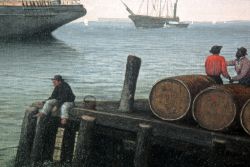
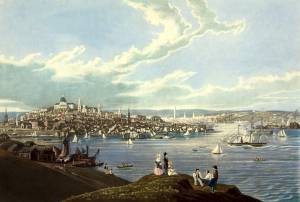
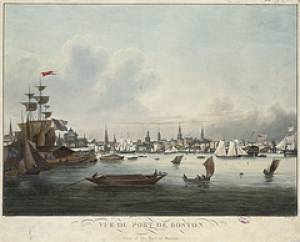

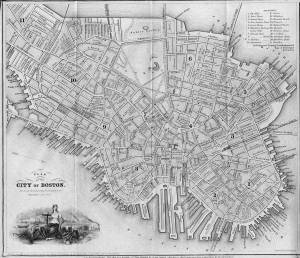
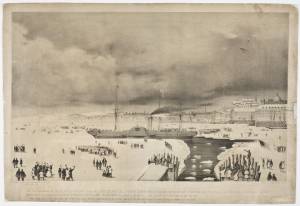

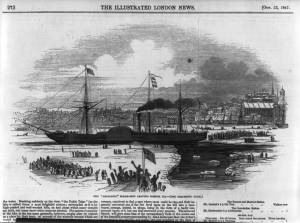

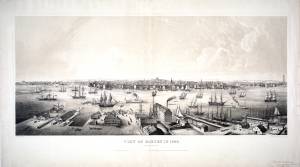
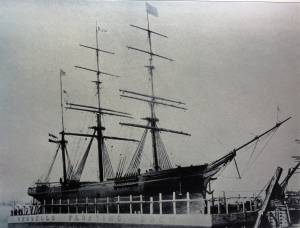
_sm.jpg)

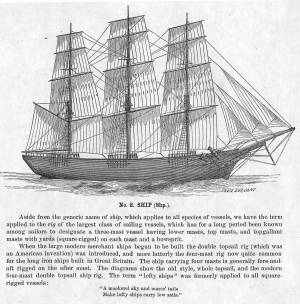
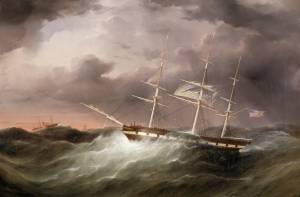






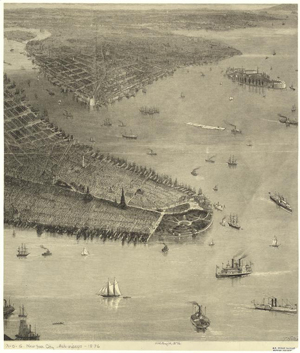
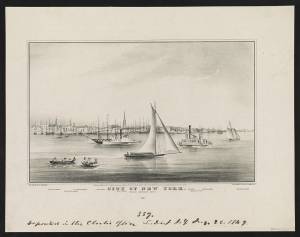
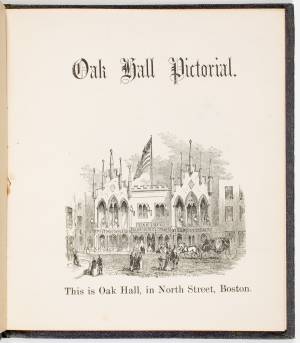
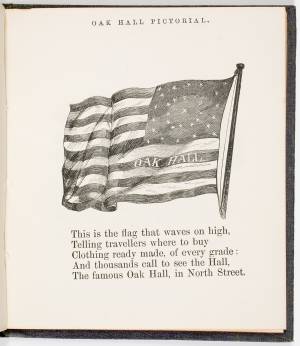
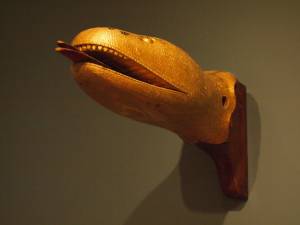
Commentary
With "Starlight's" jibs partially raised and her yards in lowered positions, the squaresails "hanging in the gear," Lane is demonstrating his knowledge of practical seamanship; "Starlight's" master is taking care of the new ship's sails. Some of the cotton canvas is almost one-eighth inch thick, and all of the sails are hand stitched, but they must be correctly treated or they will not draw properly. Any dampness in furled sails was an invitation to mildew, so it was necessary on calm, dry days to unfurl them to dry out.
The harbor in this painting has not been identified, but it is a busy one. The "Sea Dragon," with her sea-dragon figurehead and gilt diamond on the cathead, is the center of the composition. To the right, a tugboat is bringing a ship into the harbor, while a ship and several sloops, including a heavily laden utility one, are to the left. Several men are standing on the wharf, including Lane's only known depiction of an African-American man.
[+] See More